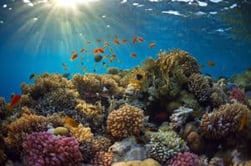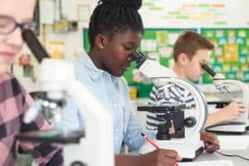Exothermic and Endothermic Reactions Inquiry Lab
Middle School Inquiry Lab on Exothermic and Endothermic Reactions
In this lab students will design a device to cool or warm a glowstick. Students will also test chemicals to use in their devices and manipulate a variable to see the effect.
Each inquiry lab will contain an essential question that will drive the lesson and make students think. For this lesson, the essential question is:
- What is the best device to release or absorb energy using a chemical process to change the behavior of a glowstick?
BACKGROUND INFORMATION AND MATERIALS LIST:
Students will begin the lab by reading the essential question and background information. This can be done individually, as lab groups, or as a whole class. If you consider lab groups, you also might include some type of whole class formative checks before digging into the lab.

Materials List:
- 250 mL beaker
- 1 teaspoon
- thermometer
- stirring rod
- calcium chloride
- ammonium chloride
- 2–3 glowsticks
- water
- assorted insulating materials
PROCEDURE:
Plan for this lab to take up two to three class periods. This lab requires students to fail before they can be successful, so you might want to discuss famous inventors' failures before you begin the lab.
Students will decide whether they would like to warm the glowstick or cool it in order for it to last longer than a day. Depending on which way students want their device to go, students will be using a specific chemical to add to their beaker with water. Students will start off with a teaspoon of chemical material and record temperature changes. Repeating this step two more times, students will then decide which variable they would like to add for the remaining three trials (either water or chemical).
Once students have decided on the amounts for their chemical reaction, they will have to decide on a design to contain the reaction and their glowstick. They will need to sketch their design and get teacher approval before being allowed to construct their container. When their construction is complete, students will add their chemicals and glowstick. In order for the students to see if their chemicals and design worked well, students will have an extra glowstick to activate, as a control, outside of the device/chemical enclosure.
Students will then be allowed to do a gallery walk around the class and see other groups’ work. At this point students can see if they would like to alter their design in any way that could possibly help with their outcome. When students return, they will need to make just one modification to change and retest. At the end, they will determine if their modification helped.
CHECK FOR UNDERSTANDING:
At this point in the lab, students will be checked for understanding by answering questions about their findings. Here are a few that come with the lab:
- What effect did your change have?
- Which combination would be best for your device? Why?
- How did your modification impact your results?
CONCLUSION
Students will go back to the essential question and write a CER (Claim, Evidence, Reasoning) to conclude the lab. Once completed, students will reflect back on their learning by answering the following questions:
- How successful was your original design?
- Was your modified design better or worse?
- How did manipulating a variable impact the chemical reaction?
MODIFIED AND INDEPENDENT INQUIRY VERSIONS
All of the Kesler Science inquiry labs come with three different modification levels. Each lab is differentiated using the icons below.
STANDARDS ALIGNMENT
NGSS: MS-PS1-6 – Undertake a design project to construct, test, and modify a device that either releases or absorbs thermal energy by chemical processes.

Download Over $100 in FREE Resources
For Middle School Science
Simply create a login below and gain immediate access to a selection of our Kesler Science product line worth $100 - for FREE. There's a full version of every product type! You'll also join tens of thousands of middle school science teachers who receive timely tips and strategies straight to their inbox.





